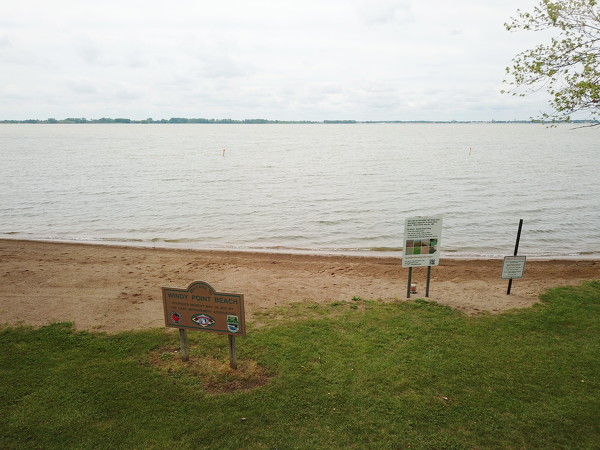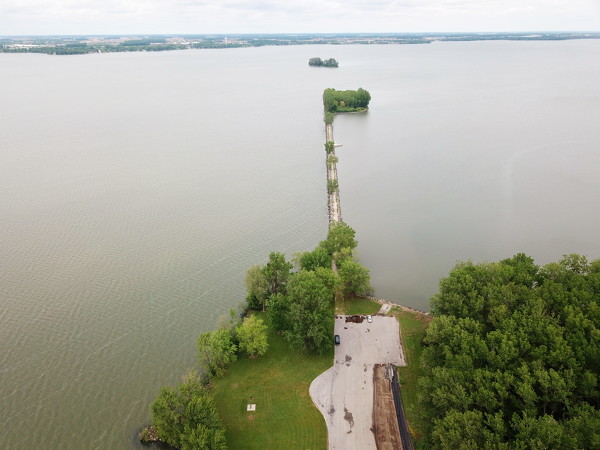Thursday, May 27th, 2021
Lake No-Contact Advisory REMOVED
Lake not fixed, but local officials are positive
By Sydney Albert

Photo by Ryan Snyder/The Daily Standard
State officials removed the advisory sign at Windy Point Beach and other beaches around Grand Lake after algal toxin levels dropped to safe levels.
CELINA - For the first time in twelve years, Grand Lake is not under a state water advisory and signs warning against coming in contact with the water were taken down Wednesday.
Activists and lake lovers rejoiced as the news began to spread. The Ohio Department of Natural Resources lifted the elevated recreational public health advisories for beaches across the lake shortly after noon. Grand Lake St. Marys State Park officials reportedly began removing the signs shortly after.
"I think it's some pretty great news," said Grand Lake St. Marys State Park Director Dave Faler. "It's the best news for this area we've had for quite some time."
Phosphorus-fed toxic blue-green algal blooms have resulted in state-issued water advisories on the 13,500-acre recreational lake every year since 2009. The local watershed is the only in the state designated as distressed due to unsafe algal toxin levels, a designation the watershed received in January 2011 after animals and humans were sickened by the toxins in 2010.
Cyanobacteria, more commonly referred to as blue-green algae, produce a toxin called microcystin, which can cause skin rashes, respiratory and gastrointestinal distress and harm the liver, Ohio EPA officials have said.
Blue-green algae activity in the lake is at its lowest levels in more than a decade, said Stephen Jacquemin, a professor of biology and research coordinator at Wright State University-Lake Campus who studies the lake's water. That doesn't mean the lake is free of algae or completely restored, but it is nonetheless a milestone, he said.
Algal blooms are driven by several factors but the main culprits are external and internal nutrient loading, Jacquemin said. External loads occur when nutrients run off the land; internal loads are nutrients already present, such as those dissolved in the water or present in sediment.
When external loading drops off, so too does algal activity. Low amounts of spring runoff and rain this year combined with years of best management practices by watershed farmers, restored wetlands and other practices have added up, Jacquemin said.
Recent samples from around the lake - in channels and in the main body of the lake on both the east and west sides - have shown microcystin levels hovering around 0.3 micrograms per liter, according to Jacquemin. The entire lake has low algal volume and toxin levels, he said.
The blue-green algae is still present in the lake, along with other algae strains naturally existing in freshwater systems, but the toxin-producing cyanobacteria is only present in small numbers.
There's no crystal ball for what the future holds. Even though the advisory has been lifted for now, there is still the potential for a toxin-producing algae bloom later in the season, he said.
Jacquemin cautioned that as summer progresses, the patterns of nutrients that feed cyanobacteria could change. While typically fed by runoff in the spring, cyanobacteria begins to feed off nutrients in the lake sediment during the summer.
The work on Grand Lake isn't done, Jacquemin said, but even so, the current lake readings are extremely positive. It's possible to have anomalous years, but the current levels weren't reached overnight, and algal activity in the lake has been trending downward for years now, he said.
"I would never have predicted the numbers would be this low, I'm ecstatic about that," Jacquemin said.
The removal of the lake's no contact advisory is something to be excited about, but it's all part of a process that must continue, he added.
Brian Miller, southwest district park manager for the Ohio Division of Parks and Watercraft, said the lifting of the lake's no-contact advisory was "very exciting," but that it is likely an advisory would return.
"We're being realistic," said Miller, former Grand Lake St. Marys State Park manager. "We'll be watching our (algal toxin) numbers and using satellite imagery provided to us," he said. "When we see something suspicious, then we'll check it out."
Miller noted a huge uptick in lake boating traffic already this season, pointing to numerous occupied state docks that in recent years sat empty.
"I'm ecstatic," said Keith Westrick, president of the Lake Improvement Association. "You're talking about a lot of people, people that's been working at this for a long time and slowly seeing progress. The condition of the lake last year and the condition of the lake this year has been exceptional."
Westrick also cautioned there's no telling what Mother Nature may yet have in store for Grand Lake. Elevated toxin levels are still possible as summer goes on. Still, he felt community efforts from around the lake, including the agricultural community, were being rewarded, and tremendous strides had been taken in the right direction.
"It's a great day," Westrick said. "We're not taking the readings and signs coming down that this is it, the job is done. It's going to be an ongoing job."
Many people across the state and country have kept a close eye on local efforts to battle toxic algal blooms as the issue becomes more prominent in other watersheds and communities, he said.
Westrick felt the return of wetlands around the lake has been a successful strategy. Much of the natural wetlands that used to surround the lake and filter out sediment and nutrients have been lost to development.
Efforts by farmers in the watershed have been invaluable, as producers have reduced nutrient loading and adjusted their fertilizer application practices, Westrick continued.
Celina Mayor Jeff Hazel had not yet received official notification about the advisory ending when reached on Wednesday, but said such a development would be a major shot-in-the-arm for local stakeholders and area tourism.
"Certainly if advisories are lifted, it's going to be a nice invitation to visitors to our area as well as people here that have boats, have homes on the lake," Hazel said. "It will certainly be an encouragement to them."
The advisory has negatively impacted lake tourism for several years, he continued.
Donna Grube, executive director for the Greater Grand Lake Visitors Region, said she and other officials are delighted with the news.
"It's exciting," she said. "Ten years of work has gone into this. It's been a long time coming."
Grube said the improved water quality is a testament to the work that's been done over the past decade, such as treatment trains, wetlands and other water quality practices.
The timing is serendipitous. Advisory signs were first placed along the lake days before Memorial Day weekend in 2009. Now, days ahead of the same holiday weekend, the signs were taken down.
"We're celebrating, and we hope it's going to be a good summer all around," Grube said.
With the advisory signs gone, Grube suggested people get outside and enjoy the West Beach area. Officials have worked to make the area safe for swimming by extending a rock wall to partially close off the beach from the rest of the lake, adding aeration to infuse the water with oxygen and disrupt algae growth, dredging out phosphorus-laden sediment and treating the water to lock up phosphorus.
- Daily Standard staff writers William Kincaid, Leslie Gartrell and Nancy Allen contributed to this story.

Photo by Dan Melograna/The Daily Standard
Knightly Hansel, 3, plays in the water at the West Beach in St. Marys on Wednesday.

Photo by Ryan Snyder/The Daily Standard
This aerial view of Grand Lake shows the Windy Point rock jetty. Algal toxin levels have dropped low enough that the state removed the water advisory.



